Ethnic Indian wear: Vibrant mix of culture and history
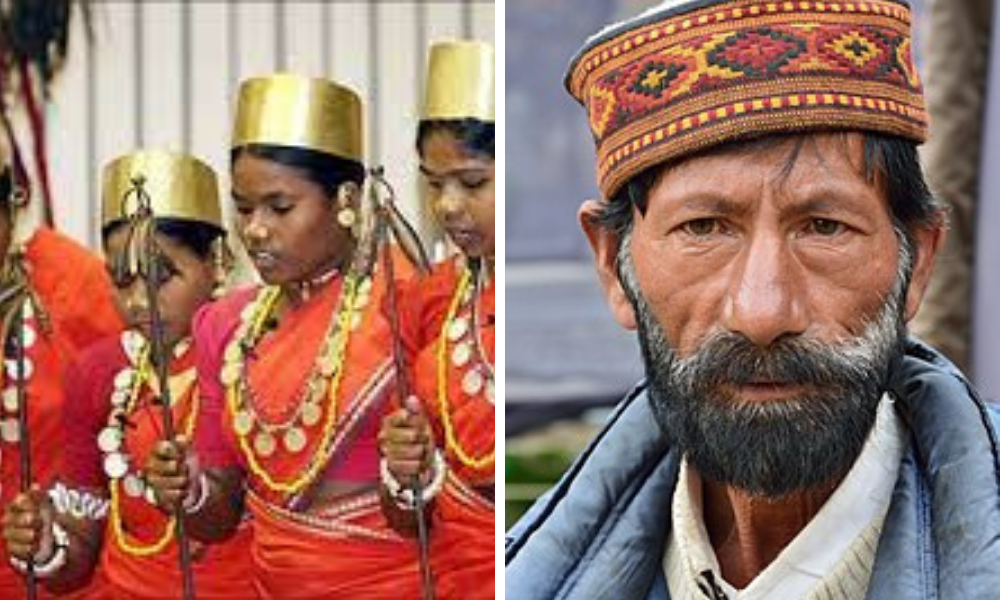
Indian traditional clothing boasts an array of colour combinations, weaving and embroidery patterns that represent's each region's cultural history (Left: Chattisgarh saree and Right: Kullu cap)
The history of Indian clothing dates back to the Indus Valley Civilisation, when clothes were dyed and spun from cotton. Stories of ancient Indian clothing have been told as far back as in the Mahabharata as well as rock sculptures and cave paintings found in Ellora. These styles have evolved to be used not only in casual everyday wear, but also on festive occasions, in wedding rituals, and for dance performances. Although the beautifully embellished lehengas, salwar kameez and sarees are well-known around the world, different colour codes, embroidery and weaving patterns, and styles of wearing the clothes vary among states and often represent specific religious or cultural values.
Arunachal Pradesh
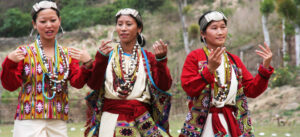
Women from Arunachal Pradesh wearing the traditional Mushaik
The attire of this north-eastern state is known for its vibrant hues and myriad of patterns and motifs embedded on shawls, wraps, skirts and ceremonial coats, that vary with each tribe’s customs.
Arunachal Pradesh has an established handloom industry as the tribals are experts in the art of weaving, using raw materials such as goat hair, human hair and tree bark. The main colours used include dark blue, red, yellow, emerald and black. These natural dyes are extracted from trees, flowers, barks and seeds.
Women often wear a full-sleeved coat with a belt tied around and a waist cloth called the Mushaik. Men wear green lungis interwoven with red, yellow and white yarn and pair it with a sleeveless silk shirt with the two edges pinned to their shoulder. Accessories such as bamboo and silver earrings often accompany the outfit. The Monpa tribe, a Buddhist community, are famous for their skull cap, called a gurdam, which is made of yak hair.
West Bengal
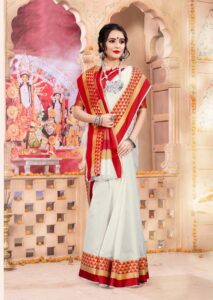
The traditional Bengali Garad saree
The Garad is the traditional Bengali saree and has a bright red border and stripes in the pallu against an un-dyed white silk bodice, worn with a unique drape where the saree is wrapped around the waist with parallel pleats tucked in the front and the pallu brought around over the other shoulder, rather than hanging from one side. With similar colour codes but a different pattern, the Korial saree is also popular in this state, flaunting intricate floral and paisley designs on the bodice. These two styles are immensely popular during Durga Puja and wedding seasons, and are matched with heavy gold jewellery, the iconic Bengali ivory/conch shell and red lacquer bangles.
For festive or religious occasions, men don a Panjabi, which is similar to a North-Indian kurta, and pair it with a dhoti, a plain loincloth made of cotton or silk that drapes down to the feet. Panjabis are usually made of popular Bengali fabrics like tussar silk or muga silk, embroidered with kantha, a running stitch of alternating vibrant hues, around the neckline or buttonholes. The colours worn during wedding ceremonies are usually various shades of beige and cream, and honey, but are can be switched for more flashy colours depending on the groom’s preference. Modern fashion has also made it popular to wear a fusion style of Panjabi with jeans or trousers for a more comfortable, but still traditional look.
Kashmir
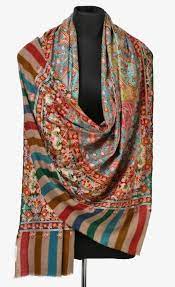
This extravagant silk thread pashmina shawl retails for INR 137,700 (Photo: Kashmir Box)
The extravagant Pheran is a major tourist attraction for visitors to Kashmir. A mixture of Persian and Indian styles, the unisex outfit is a go-to for the Valley’s harsh winters and is a loose kurta-style dress that goes down to the knees or feet. It was originally brought over by Mughal Emperor Akbar in 1586 when he conquered the Valley. When worn by women, the dress usually has Zari embroidery on the hemline and around the pockets and collar.
Certain accessories of traditional Kashmiri outfits have been adapted to Western styles and are popular all over the world. In particular, the pashmina shawl, which is made from the goat hair of a Pashmina goat and is a fine variant of spun cashmere, is very expensive and often in great demand from both locals and tourists. Many of these shawls also boast intricate embroidery as well as hybrid fabric options, such as a soft exquisite silk mixed with the pashmina hair for a softer and shinier finish.
Chhattisgarh
Chhattisgarh also has several tribal and ethnic groups with their own unique take on fashion. The Kachchora saree is unique to this state and consists of a lugda paired with a polkha, a blouse. These special sarees are a tourist attraction of the state and are even sold as part of the Chhattisgarh cultural section at national festivals such as the SurajKund Mela held near New Delhi each year in the month of February.
Influenced by designs of Madhya Pradesh, the sarees are typically machine-made and printed using fabric available in woven, tie-dye or batik styles. Batik is an ancient art that involves waxing, dyeing and scraping to create beautiful, unconventional designs on fabric. The design is popular all over the world, especially in Indonesia. For tie-dye, the cloth is tightly tied with threads and then dipped in bright, multi-coloured dyes, which creates exciting, flashy prints; this technique is also known as Bandhani.
The accessories used by the women are an essential part of the outfit, such as bandhaa, a necklace made out of coins, Pounchhi, a ring worn on the upper arm, and Bichhiya, a traditional marital ring worn on the toe.
Himachal Pradesh
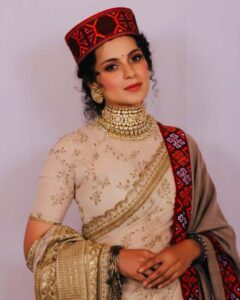
Himachal Pradesh native and Bollywood actress Kangana Ranaut dons a Kullu cap
The heavy, colourful Chambyali dress is very popular in Himachal Pradesh and is native to the Gaadis community who live in Chamba. Women wear a pattoo over their clothes and pin both the ends with silver brooches called boomini, which is a long silver chain that covers the whole body. A piece of cloth is tied around the waist acts as a belt, and is known as gachchi. Finally, the Dhatu or Thipu is a square piece of cloth that covers the head and is complemented by heavy silver ornaments and jewellery. The men wear churidaar pajamas, which are long overcoats made of the Yak leather over their starch-stiffened kurtas. These are embroidered with gold and accompanied with varying colours of turbans to match.
Other shawls and woollens are made in varying colours and designs using fur of animals such as lamb, yak and Angora fibres with woven animal and plant designs on white or pale yellow base shades.
The stylish headgear is known as the Kullu top or Malana topi, and is found in the Kullu region of Himachal Pradesh. The caps are stiff and circular, made of wool for the winter season and cotton to suit warm summers, or even velvet for special occasions. They can be a plain or muted colour throughout, or have multi-coloured geometric designs.









